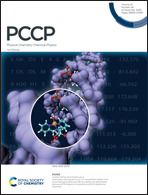Abstract
The unimolecular decomposition of acetyl peroxy radicals followed by subsequent nitration is known to lead to the formation of peroxy acetyl nitrate (PAN) in the troposphere. Using high level quantum chemical calculations, we show that the acetyl peroxy radical is a precursor in the formation of tropospheric ketene. The results show that the presence of a single or double water molecule(s) as a catalyst does not influence the decomposition reaction directly to form ketene and hydroperoxy radicals. The electronic excitation of the reactive and product complexes occurs in the wavelength range of ∼1400 nm, suggesting that the complexes undergo photoexcitation in the near IR region. The results ascertain that the dissociation of acetyl peroxy radicals into ketene and hydroperoxy radicals occurs more likely through the excitation route and the corresponding excitation wavelength reveals that the reactions are red-light driven. Three different product complexes, ketene·HO2, ketene·H2O·HO2 and ketene·(H2O)2·HO2, are formed from the reaction. The direct dynamics simulations show that the product complexes are more stable and possess a long lifetime. The calculated temperature dependent equilibrium constant of the product complexes reveals that their atmospheric abundances decrease with increasing altitudes.

- This article is part of the themed collection: 2020 PCCP HOT Articles


 Please wait while we load your content...
Please wait while we load your content...